Qualcomm Snapdragon 805 Performance Preview
by Anand Lal Shimpi on May 21, 2014 8:00 PM EST- Posted in
- Tablets
- Snapdragon
- Qualcomm
- Mobile
- SoCs
- Snapdragon 805
CPU Performance
As always we'll start out our performance investigation with a handful of CPU bound web browser based tests. In all cases we used Chrome on the MDP/T. Remember there's only an 8% increase in peak CPU frequency here, so I wouldn't expect a huge difference vs. Snapdragon 801.
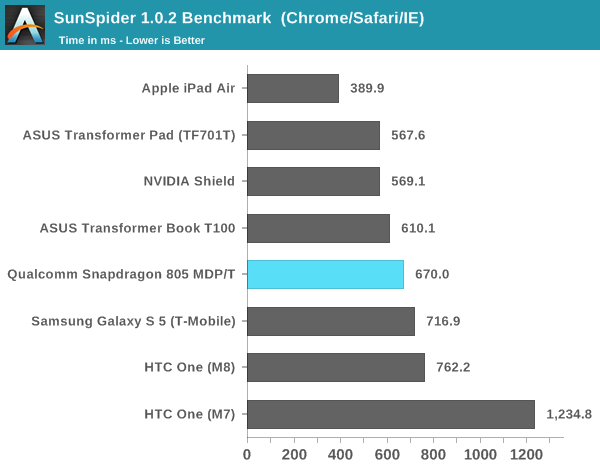
Here the MDP/T scales pretty well, showing a 6% improvement in performance over the Snapdragon 801 based Galaxy S 5. In the case of the GS5 we are looking at a 2.5GHz Snapdragon 801 implementation, so the improvement makes sense. Both the Cortex A15 (TF701T/Shield) and Apple's Cyclone (in the iPad Air) are higher performing designs here. Since there's no fundamental change to Krait's IPC, the only gains we see here are from the higher clock speed.
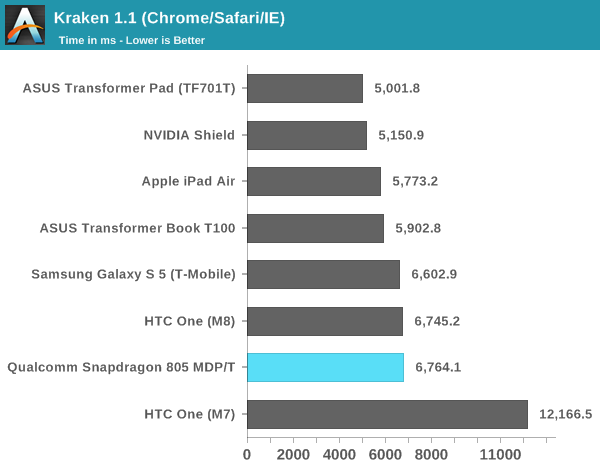
Kraken appears to be at its limit when it comes to Krait 400/450, there's effectively no additional frequency scaling beyond 2.3GHz. We're either running into an architectural limitation or limits of the software/browser combination itself.
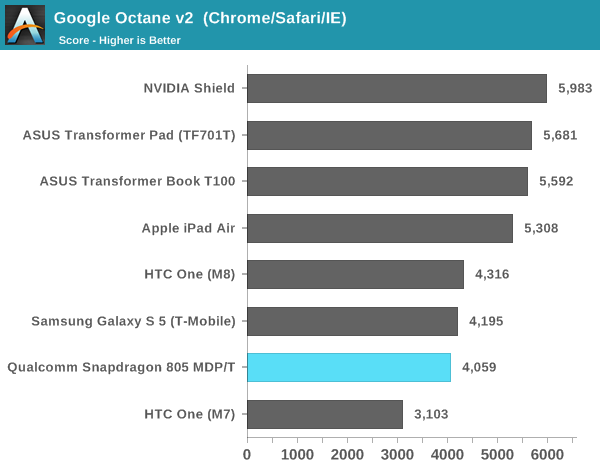
Similarly we don't see any real progress in the Google Octane test either. Snapdragon 805's CPU cores may run at a higher peak frequency but that's definitely not the story here.
Basemark OS II
Basemark OS II gives us a look at native application performance across a variety of metrics. There are tests that hit the CPU, GPU as well as storage subsystems here. The gains here are exclusively on the graphics side, which makes sense given what we've just seen. Snapdragon 805's biggest gains will be GPU facing.
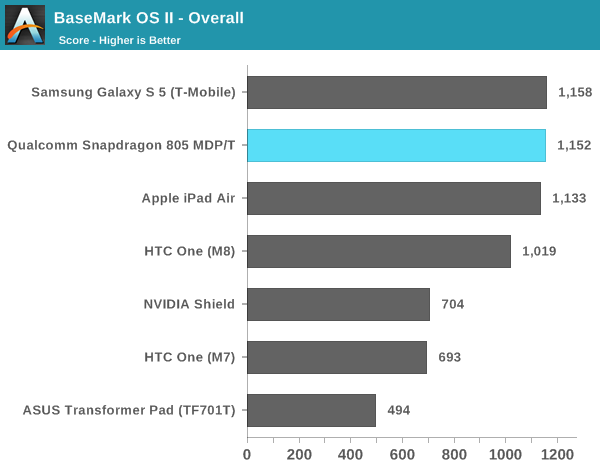
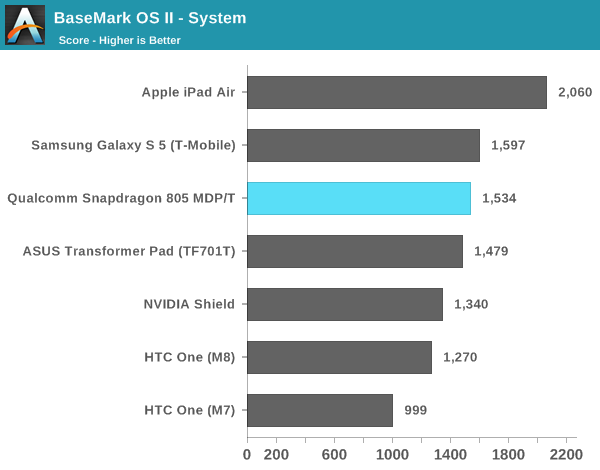


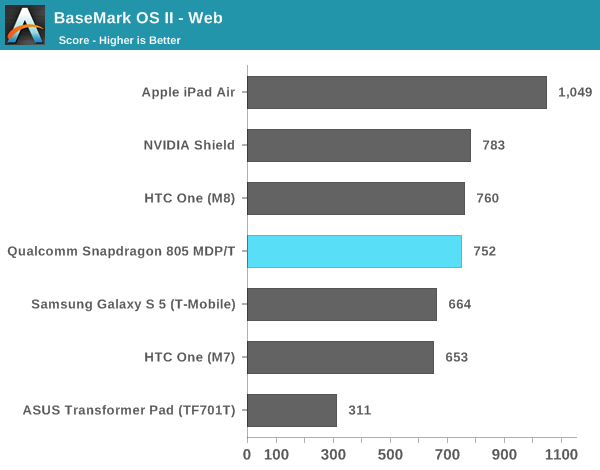
Geekbench 3.0
Although I don't typically use Geekbench, I wanted to include some numbers here to highlight that the increase in memory bandwidth for S805 over S801 doesn't really benefit the CPU cores:
| Geekbench 3.0 | |||||
| Snapdragon 801 2.3GHz (HTC M8) | Snapdragon 805 2.7GHz (MDP/T) | % Increase for S805 | |||
| Overall (Single thread) | 1001 | 1049 | 4.8% | ||
| Overall (Multi-threaded) | 2622 | 2878 | 9.7% | ||
| Integer (Single thread) | 956 | 996 | 4.2% | ||
| Integer (Multi-threaded) | 2999 | 3037 | 1.3% | ||
| FP (Single thread) | 843 | 925 | 9.7% | ||
| FP (Multi-threaded) | 2636 | 3155 | 19.7% | ||
| Memory (Single thread) | 1411 | 1406 | 0% | ||
| Memory (Multi-threaded) | 1841 | 1949 | 6% | ||
I wouldn't read too much into the multithreaded FP results, I suspect we're mostly seeing differences in thermal dissipation of the two test units. A closer look at the memory bandwidth numbers confirms that while the 805 has more memory bandwidth, most of it is reserved for GPU use:
| Geekbench 3.0 - Memory Bandwidth | |||||
| Snapdragon 801 2.3GHz (HTC M8) | Snapdragon 805 2.7GHz (MDP/T) | % Increase for S805 | |||
| Stream Copy (Single thread) | 7.89 GB/s | 8.04 GB/s | 1.9% | ||
| Stream Copy (Multi-threaded) | 9.53 GB/s | 10.1 GB/s | 5.9% | ||
| Stream Scale (Single thread) | 5.36 GB/s | 5.06 GB/s | - | ||
| Stream Scale (Multi-threaded) | 7.31 GB/s | 7.63 GB/s | 4.3% | ||
| Stream Add (Single thread) | 5.27 GB/s | 5.2 GB/s | - | ||
| Stream Add (Multi-threaded) | 6.84 GB/s | 7.51 GB/s | 9.8% | ||
| Stream Triad (Single thread) | 5.64 GB/s | 5.85 GB/s | 3.7% | ||
| Stream Triad (Multi-threaded) | 7.65 GB/s | 7.89 GB/s | 3.1% | ||










149 Comments
View All Comments
phoenix_rizzen - Friday, May 23, 2014 - link
Snapdragon S4 Pro didn't have an integrated modem (APQ80xx) and it sold quite well into phones like the LG Optimus G / Nexus 4.jerrylzy - Thursday, May 22, 2014 - link
The Memory Interface of Snapdragon 805 should be 2 x 64bit instead of 4 x 32bit...Zaydax - Thursday, May 22, 2014 - link
Just noticed: First page of the review says 32 nm. Aren't these all 28nm?As always, great review!
Zaydax - Thursday, May 22, 2014 - link
Never mind. totally read that wrong. It said 32 bit...jjj - Thursday, May 22, 2014 - link
At least it's not just a rebrand like the 801, we want 20nm already!On the flip side, really looking forward to the A53 SoCs about to arrive from Qualcomm and Mediatek, the Allwinner A80 quad A15, the Rockchip RK3288 with it's quad A17 (not sure it's not A12 ,we'll see soon i guess) and the quad A17 MediaTek MT6595. The more budget side should be getting some nice perf boost.
And while at it, heave you guys heard anything about Intel investing/collaborating with Rockchip?
hahmed330 - Thursday, May 22, 2014 - link
I actually found very detailed power consumption figures for Jetson Tegra K1.... I am quite surprised how low power it is... I am quite surprised anand missed that... Here is the link....http://developer.download.nvidia.com/embedded/jets...
Also for even more geeky details including the schematics...
https://developer.nvidia.com/jetson-tk1-support
hahmed330 - Thursday, May 22, 2014 - link
660 mW at idle... 3660 mW running at iPhone 5S speed... At full load at 950mhz 6980mW...These numbers are SOC+DRAM...
henriquen - Thursday, May 22, 2014 - link
"Tegra K1 performance measured on Jetson TK1 platform running LINUX"Ryan Smith - Thursday, May 22, 2014 - link
Memory bandwidth! Sweet, sweet memory bandwidth!bradleyg5 - Thursday, May 22, 2014 - link
Hope this chipset doesn't just come on 2560x1440 screens because the bump in performance isn't going to match the increased demands of that resolution.The only test you did that reflects real world gaming(in my experience) is 3d mark so it's pretty shocking how poor it does.
40% improved performance might as well mean nothing because the current chips rarely even run full power. So basically a 20% power efficiency bump is the only thing that will be actualized.
X-Com will drain my note3's entire battery in about 2 1/2 hours where the 800 runs full power.
The better shader support is by far the biggest news, direct x 11 effects are solely needed, shaders in games currently look like direct x 7. So that's a massive leap.
All the visual fidelity currently comes from running games at very high resolution with high poly counts. I wonder if in the next generation we are going to see developers run games under native resolution, think of what you could do with shaders running at 720p instead of 1440p. Now that you have all the advanced lighting and shadowing effects why would you want to burn up all your performance on super high resolutions.
The xbox 1 and ps4 don't even run most games at 1080p it's sort of crazy that mobile games do. You aren't going to get ps3 level graphics at 1440p but you could at 720p.